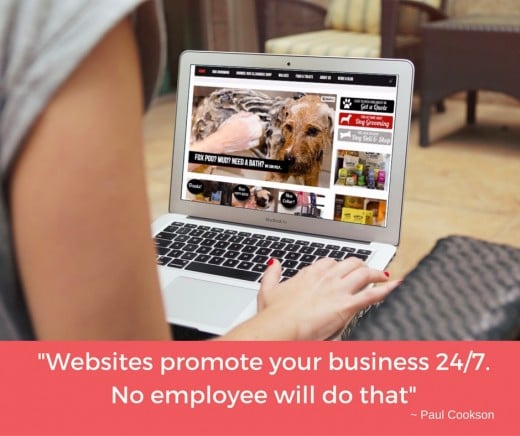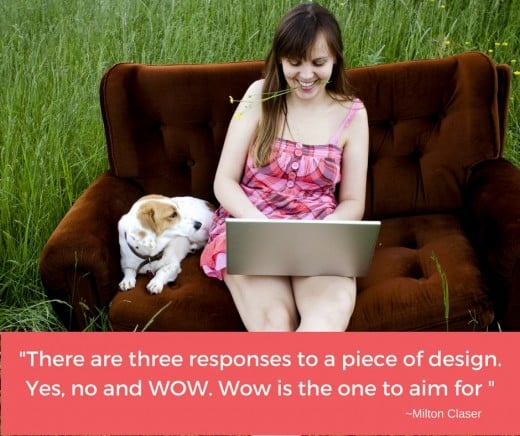How to Build a DIY Pet Business Website on a Shoestring

Does the thought of building a pet business website make you feel overwhelmed? Perhaps you don’t have any knowledge of building and designing a website, or have the budget to hire a web designer? Perhaps you're just not sure where to start?
In this article, you'll learn the first 4 steps you need to take before you spend any time or money on new your site, and how you can save a small fortune by doing your homework and going down the DIY route.
Step 1 - Deciding Who Will Build Your Pet Business Website
When it comes to building a pet business website you have two main tech choices.
Either you pay someone like a web designer or techy friend to do it for you, or you learn how to do it yourself. Paying a web designer could set you back anything from $1000 to $20-30k, depending on what you’re asking them to build for you.
If you’re going down the DIY route on the other hand, then I have some great news – it will be cheaper and you will remain control of your website because you’ll know exactly how to add content and change things around on your site.
You don’t even have to learn coding because you can use ‘done for you’ website templates from a variety of website suppliers like the ones listed below. All you need to do is prepare the text you want on your site, collect the images you want to use and start populating their templates with your content. Easy peasy.
The main thing you need to know before making a decision, is that a website is not a ‘set it and forget it’ type of marketing tool.
It is incredibly important that you’re able to login to your website yourself, and be able to add new pages and blog posts, change outdated content, add new images and move things around to accommodate new service offerings or products.
You need to be in total control of your own website - it is the cornerstone of your pet business and all other forms of marketing and promotions will lead to customers seeing your website.
Even if you hire a web designer to build your website - be sure to ask which platform they will develop it on and whether you will be able to add and change content yourself easily once the page has been built.
If they say no - go elsewhere.

Step 2 - What's your budget?
The main costs you need to consider for your website budget are:
-
Hosting costs: Hosting means the ‘space’ you ‘rent’ to build your website on. There are several good hosting companies to choose from and the market changes daily. Expect to pay around $100/year for hosting when you first start out, or look for website builders/platforms that include hosting in their fees.
- Domain name:Your domain name is a lot like a unique street address for your website - for example www.MyPetBiz.com. Expect to pay around $15/year to reserve your domain name. Some website platforms allow you to build a website for free on one of their ‘subdomains’, meaning their name will appear in your URL (and sometimes some advertising on your site). Although this is great for trying out their service - in the long run it looks unprofessional, and your website will rank lower in Google search results.
- Set Up Cost: Hiring a web developer could cost anything from $1000 -$20 000 or more, depending on what you ask them to create. If you decide to go down the DIY route, you're only investing your own time.
- Maintenance cost: Some website platforms such as Wordpress need to be updated and maintained regularly to run smoothly and stay safe (so you don’t get hacked). Some website platforms perform these updates and safety checks in the background so you don’t need to worry about a thing.
You can either do these updates yourself, or get your web developer to do it for you. Costs for these services may vary depending on what your ‘web guy’ charges, but expect to pay around $75-100/hour.
Take the Pet Pro Poll!
Which Website Builder Will You Use?
Step 3 - Which website builder will you use?
Whether you’re hiring a web developer (or techy friend) or choose the DIY route, you’re likely going to end up using one of the following popular website builders.
They are also sometimes referred to as website platforms, or content management systems (CMS).
There is no right or wrong choice here, which platform you should choose depends on your overall business goals, and your own skill level and budget.
Wordpress.org (not wordpress.com)
I've been using Wordpress for years for my pet blog as well as for my pet business marketing website. It is without a doubt one of the most powerful website platforms out there, and you can choose from thousands of themes, widgets and plugins to build, personalize and perfect your perfect pet business website. Wordpress itself is free to use, although some of the templates are sold relatively cheaply and you would need to organize and pay for your own hosting and domain name.
The main downside with Wordpress though is the steep learning curve - as long as the template you want to use looks perfect, then you might be okay. But as soon as you want to move an image or email sign up box from one side of the screen to the other you need to read up on how that particular template works, or learn how to code - both of which are not ideal when you're busy running your own pet biz. In short - Wordpress is a great choice if you're already website savvy, or have a techy friend nearby.
Weebly, Squarespace and Wix are all website builders that are a whole lot easier to use than Wordpress, and will cause you less grey hairs in the process. Just like Wordpress you start off with a template you like, and then you use their easy drag and drop style website building tools to personalize your website until it looks just the way you want it. Another advantage is that they all have packages where everything is included so you don't have to worry about finding hosting and buying your domain name elsewhere.
The downside with these website builders is that they integrate with fewer third party apps like your booking software, email suppliers like Mailchimp, and so on so be sure to check this before you sign up. They are also a little bit more expensive on a monthly basis than a Wordpress site - but for that money you gain full control of your site and everything web related is 'in one place'.
Compare the right things when you choose
Many pet business owners make the mistake of only comparing prices when they set up a website because they don’t fully understand what to look for and think that all websites are built equal.
BIG Mistake!
The market changes daily, and I recommend that you search for a few website builder comparison sites, to compare the web builder platforms most recent offerings.
Don't let price be the only consideration when choosing which website builder to use!
— Linda Liebrand
Choosing a Website Builder for Your Pet Business
Here's what you need to consider when choosing a website builder for your pet business website
-
Learning curve - the learning curve for the different platforms vary. The good news is that many of the platforms allow you to create a free website, and I encourage you to do so to try out the drag and drop tools etc. You will quickly get an idea of whether you feel confident using their tools or not.
- Level of control/ability to change templates so they suit your business needs. All the website platform options provide ready made templates that would be suitable for your pet business. The trick question is how easy it is to adapt the template to suit your business needs. For example - if you love the layout of template A but want it in pink, do you have control over colour choices?
Or, if you love template B but want to move the enquiry form from the sidebar to the homepage - do you need to hire a web developer, or could you manage it yourself with a few clicks of a button?
If your web developer will code the website from scratch, what happens if you want to make changes? - Maintenance and Safety. Some of the platforms keep the software up to date automatically without you having to do a thing. Others, require you to regularly run updates to keep plugins and themes up to date. Small website such as yours can, and do, get hacked regularly - so keeping the website software up to date is essential! (This excellent video from Google, explains why and how websites get hacked in case you’d like to learn more).
-
Pricing. Check what your total cost including setting up the site, hosting, support and domain name will be initially and per year going forward
- Is hosting included? Some of the website platforms include their own hosting, and others let you have total control over which hosting provider you choose.
- Is there customer support? Some of the options do not have customer support included, whereas others do.
- Are there good looking templates that you can adapt to your business? Check if the provider has any templates that you can use as a starting point and adapt for your pet business.
- Can you add an email signup box easily? Email is an incredibly important tool for promoting your pet business. You want to be able to place an ‘opt in box’ anywhere on your site, including your home page. An opt in box is where pet parents enter their name and email to join your email list.
- Can you integrate your favourite email provider, for example Mailchimp? Some of the platforms allow you to integrate with any type of email system, whereas others tie you into using their own email system.
Check that you have total control over which email supplier you can integrate with your template - and whether you have full access to the names and emails in your list should you ever wish to download them. - Are the templates mobile responsive? Local search is on the increase, and people use their mobile phones to locate all things local. Google recently announced that websites that are mobile responsive will received preferential treatment in their search results listings.
- Can you easily add a blog? Adding a blog to your website will drastically increase your chances of being found online. Most of the platforms will allow you to add a blog section to your website, but go ahead and check how easy it is to do so, and whether your template already includes a blog section.
- Can you easily add testimonials and social media share buttons? Social proof is a key ingredient in getting pet parents to feel like they know, trust and like you, so always check whether you can easily include testimonials and social media widgets.
Website Builder Decision Matrix
Wordpress
| Weebly
| Wix
| Other
| |
|---|---|---|---|---|
Learning Curve
| ||||
Level of Control
| ||||
Maintenance & safety
| ||||
Customer support
| ||||
Good looking templates?
| ||||
Can you add an email sign up box?
| ||||
Can you integrate your favourite email supplier?
| ||||
Can you easily add testimonials and reviews?
| ||||
Are the templates mobile responsive?
| ||||
Can you easily add a blog section?
| ||||
Total cost incl. Hosting, setup and maintenance.
| ||||
Total score
| ||||
When researching the website builders, add your notes or scores to the decision matrix Then choose your favourite builder!

Step 4 - Write a Website Brief
Whether you’ve decided to get a website developer onboard, or if you’re DIY’ing your website - filling out a simple website briefing form before you start working on the site will help you enormously.
It will provide you, or your developer, with a clear road map to a successful pet business website and nothing will get missed.
Taking the time to write the brief, will benefit your business in many other ways:
- You will provide clear instructions to the web developer who might not be familiar with your industry and what a pet business website needs to contain.
- You will be less likely to come across misunderstandings, and costly revisions later down the road.
- Clear deadlines and scope of the whole project so a budget and time allocation can be set.
Sample Website Briefing Form
- About your Pet Business.
- What are your Marketing/Business goals in the coming 12 months.
- Who are your main competitors?
- What’s stopping customers from buying your services right now?
- Describe the exact services and products offered by your pet biz
2. Expectations of the website
Why do you want a website in the first place and what do you want to happen after the site is up?
For example: more enquiries via web form, more phone calls, more email sign ups. Be as specific as you can.
3. Target Audience - who will see the website?
Describe your ideal client in as much detail as possible. Gender, age, demographics, type of pets owned. What type of ‘dog problems’ do you help solve?
- Project management
- Deadlines & budget
5. Content
Who will write the copy (text). What photos and videos will you use and where are they stored? Who will make this website SEO optimized? (learn more about the importance of SEO later in this book)
6. What specific functionality is needed?
Booking forms, contact forms, email subscription form, search box, blog section
7. Graphic design and usability
What are your brand colours, fonts and logo? What visual tone are you looking for? E.g. Whimsical vs. serious. Give examples of websites you like and some that you don’t like - and give examples of what exactly it is about those pages that you do/don’t like.
8. Technical
Do you already have hosting? What is the current hosting service. Do you own your own domain name yet?
10. What training will you need?
What training will you require to be able to add/change content on the website.
With a good website brief and the right website builder for your business, you have all the tools you need to start planning your own website - good luck!
© 2016 Linda Liebrand








